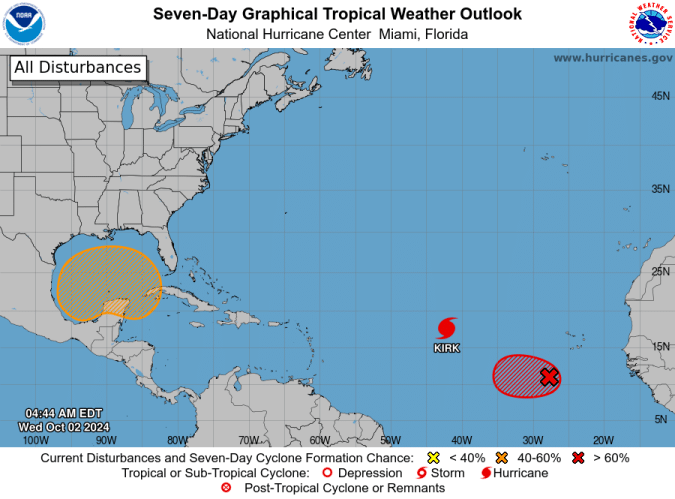
Listen to WCOA’s “Real News with Rick Outzen” at 7 a.m. to get the latest information.
“I have run the models on it this morning. Both GFS and the European had nothing developing out of it honestly, but it’s still got a chance,” Gilmore said. “There’s a lot of wind shear down there. That wind shear is going to create a lot of havoc on it, and we’ll see what happens when it gets through this shear.”
NOAA HURRICANE CENTER
NWS National Hurricane Center Miami FL
200 AM EDT Wed Oct 2 2024
For the North Atlantic…Caribbean Sea and the Gulf of Mexico:
Active Systems:
The National Hurricane Center is issuing advisories on Hurricane
Kirk, located over the central tropical Atlantic Ocean.
1. Northwestern Caribbean Sea and Gulf of Mexico:
A broad trough of low pressure is producing a large area of
disorganized showers and thunderstorms from the southwestern
Caribbean Sea into the southern Gulf of Mexico. Environmental
conditions could support some gradual development of this system,
and a tropical depression could form over the weekend as the broader
disturbance moves fully into the Gulf of Mexico. Interests along the
U.S. Gulf Coast should continue to monitor the progress of this
system.
* Formation chance through 48 hours…low…near 0 percent.
* Formation chance through 7 days…medium…40 percent.
ACCUWEATHER
AccuWeather’s long-range and hurricane experts have pointed out that the next new threat to the U.S. would likely be from the Gulf of Mexico and the western Caribbean. That development zone is being narrowed down to the southern gulf, and the birth of a new storm could occur as early as this weekend or early next week.
- “Water temperatures continue to remain warm in the wake of Helene over the southeastern Gulf of Mexico,” AccuWeather Lead Hurricane Expert Alex DaSilva said. “Not only is the surface water warm, but it remains warm down deep so that wave action from any storm has little cooling effect.”
The minimum water temperature for full tropical development is 78-80 F. Water temperatures in the southern Gulf of Mexico and northwestern Caribbean Sea remain well into the 80s. Read more.



